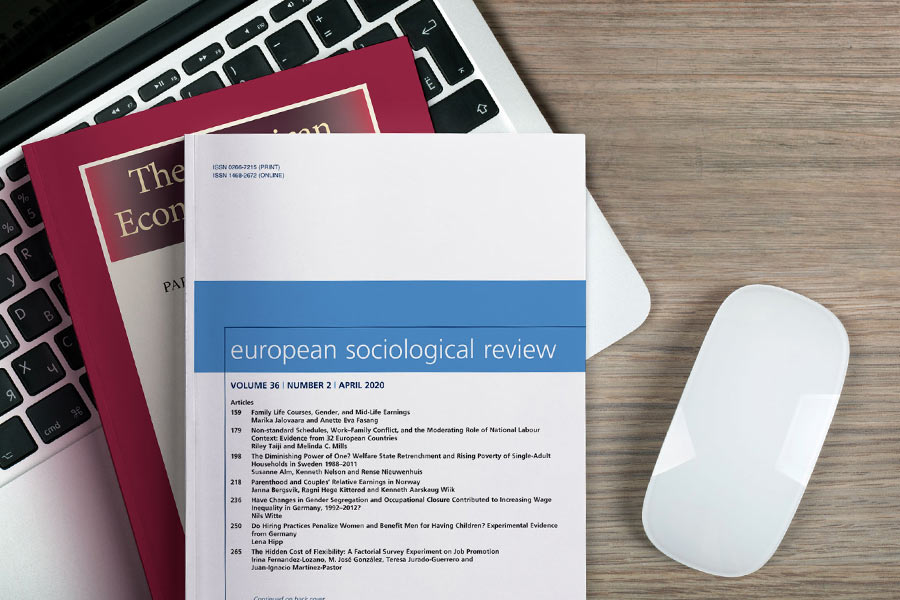Total hits 17.329
-
Changes in conscientiousness during adolescence – the role of intelligence
Friedrich, T. & Schütz, A. (2025): Changes in conscientiousness during adolescence – the role of intelligence. In: Personality Science, Vol. 6. DOI:10.1177/27000710241309790
-
Forschung und Politikberatung benötigen ein Forschungsdatengesetz: Lehren aus dem IAB
Fitzenberger, B. & Müller, D. (2025): Forschung und Politikberatung benötigen ein Forschungsdatengesetz: Lehren aus dem IAB. In: IAB-Forum No. 13.02.2025. DOI:10.48720/IAB.FOO.20250213.01
-
Arbeitsmarktintegration ukrainischer Geflüchteter
Kosyakova, Y., Brücker, H. & Koch, M. (2025): Arbeitsmarktintegration ukrainischer Geflüchteter. Berlin.
-
Arbeitsmarktintegration nicht-ukrainischer Geflüchteter
Brücker, H., Kosyakova, Y. & Koch, M. (2025): Arbeitsmarktintegration nicht-ukrainischer Geflüchteter. Starker Anstieg der Erwerbstätigenquoten mit zunehmender Aufenthaltsdauer. Berlin.
-
Wenn Ihr Job von KI betroffen ist, kann das eine große Chance sein
Weber, E. (2025): Wenn Ihr Job von KI betroffen ist, kann das eine große Chance sein. Gastbeitrag. In: Frankfurter Allgemeine Zeitung No. 12.02.2025 Frankfurt am Main.
-
Ältere gehen im Westen später in Rente als im Osten und auf dem Land früher als in Städten
Dauth, W. & Hirschenauer, F. (2025): Ältere gehen im Westen später in Rente als im Osten und auf dem Land früher als in Städten. In: IAB-Forum No. 11.02.2025. DOI:10.48720/IAB.FOO.20250211.01
-
Bürgergeld: Kooperation statt Aktivierung? Konzeptionelle Einordnung und erste Bewertungen
Dietz, M. (2025): Bürgergeld: Kooperation statt Aktivierung? Konzeptionelle Einordnung und erste Bewertungen. In: Archiv für Wissenschaft und Praxis der sozialen Arbeit, Vol. 56, No. 1, p. 16-27.
-
Betriebliche Aus- und Weiterbildung als Strategien der Fachkräftesicherung
Leber, U. & Schwengler, B. (2025): Betriebliche Aus- und Weiterbildung als Strategien der Fachkräftesicherung. In: Berufsbildung in Wissenschaft und Praxis, Vol. 54, No. 1, p. 8-12.
-
Welche Betriebe nehmen die Weiterbildungsförderung der BA in Anspruch?
Leber, U. (2025): Welche Betriebe nehmen die Weiterbildungsförderung der BA in Anspruch? In: Denk-doch-Mal.de No. 1.
-
Employment of elderly: Those who work besides retirement rarely change occupations
Trahms, A. & Vicari, B. (2025): Erwerbstätigkeit von Älteren: Wer neben der Altersrente arbeitet, wechselt nur selten den Beruf. (IAB-Kurzbericht 01/2025), Nürnberg, 8 p. DOI:10.48720/IAB.KB.2501
-
Die Qual der Wahl? Soziale Strukturierungen der tariflichen Wahlmöglichkeit zwischen Zeit und Geld
Abendroth-Sohl, A., Bächmann, A., Mellies, A. & Ruf, K. (2025): Die Qual der Wahl? Soziale Strukturierungen der tariflichen Wahlmöglichkeit zwischen Zeit und Geld. In: WSI-Mitteilungen, Vol. 78, No. 1, p. 22-29. DOI:10.5771/0342-300X-2025-1-22
-
Immigration monitor January
Brücker, H., Hauptmann, A. & Keita, S. (2025): Zuwanderungsmonitor Januar. (Institut für Arbeitsmarkt- und Berufsforschung. Aktuelle Daten und Indikatoren), Nürnberg, 8 p. DOI:10.48720/IAB.ZM.2501
-
Maßnahmen der aktiven Arbeitsmarktpolitik verbessern die Arbeitsmarktchancen Geflüchteter auch langfristig
Kasrin, Z. & Tübbicke, S. (2025): Maßnahmen der aktiven Arbeitsmarktpolitik verbessern die Arbeitsmarktchancen Geflüchteter auch langfristig. In: IAB-Forum No. 05.02.2025 Nürnberg. DOI:10.48720/IAB.FOO.20250205.01
-
Asylpolitik: Wie geht es mit den syrischen Geflüchteten in Deutschland weiter?
Weber, E. (2025): Asylpolitik: Wie geht es mit den syrischen Geflüchteten in Deutschland weiter? In: Makronom No. 05.02.2025.
-
Do xenophobic attitudes influence migrant workers’ regional location choice?
Buch, T., Burkert, C., Hell, S., Niebuhr, A. & Haas, A. (2025): Do xenophobic attitudes influence migrant workers’ regional location choice? In: PLoS ONE, Vol. 20, No. 2. DOI:10.1371/journal.pone.0316627
-
"IAB-Kompetenz-Kompass“ Bereitstellung von Stellentext-Daten als strukturierter Datensatz
Stops, M., EzElDin, A., Heckel, M., Heß, P., Klevinghaus, H., Malfertheiner, V., Metzger, L. & Peede, L. (2025): "IAB-Kompetenz-Kompass“ Bereitstellung von Stellentext-Daten als strukturierter Datensatz. (IAB-Forschungsbericht 01/2025), Nürnberg, 259 p. DOI:10.48720/IAB.FB.2501
-
Maternal and Child Health Following 2 Home Visiting Interventions vs Control
Schepan, M., Sandner, M., Conti, G., Kliem, S. & Brand, T. (2025): Maternal and Child Health Following 2 Home Visiting Interventions vs Control. Five-Year Follow-Up of a Randomized Clinical Trial. In: JAMA pediatrics, Vol. 179, No. 4, p. 367-374. DOI:10.1001/jamapediatrics.2024.5929
-
Wie fair empfinde ich meinen Lohn? Das Arbeitsumfeld macht den Unterschied
Brüggemann, O., Hinz, T., Lang, J., Strauss, S. & Zubanov, N. (2025): Wie fair empfinde ich meinen Lohn? Das Arbeitsumfeld macht den Unterschied. In: IAB-Forum No. 03.02.2025 Nürnberg. DOI:10.48720/IAB.FOO.20250203.01
-
Labor Market Concentration in Germany
Oberfichtner, M. & Popp, M. (2025): Labor Market Concentration in Germany. (IZA discussion paper / Forschungsinstitut zur Zukunft der Arbeit 17745), Bonn, 47 p.
-
Beruflicher Wandel in Baden-Württemberg: Nimmt die Bedeutung umweltschonender Kompetenzen zu?
Faißt, C., Hamann, S., Jahn, D., Janser, M., Otto, A., Wapler, R. & Wydra-Somaggio, G. (2025): Beruflicher Wandel in Baden-Württemberg: Nimmt die Bedeutung umweltschonender Kompetenzen zu? (IAB-Regional. Berichte und Analysen aus dem Regionalen Forschungsnetz. IAB Baden-Württemberg 01/2025), Nürnberg, 39 p. DOI:10.48720/IAB.REBW.2501



